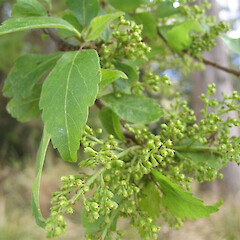Plagianthus regius subsp. regius
Common name
mānatu, ribbonwood, lowland ribbonwood
Synonyms
Philippodendrum regium Poiteau, Plagianthus betulinus A.Cunn., Plagianthus betulinus A.Cunn. var. betulinus, Plagianthus urticinus A.Cunn.
Family
Malvaceae
Flora category
Vascular – Native
Endemic taxon
Yes
Endemic genus
Yes
Endemic family
No
Structural class
Trees & Shrubs - Dicotyledons
NVS code
The National Vegetation Survey (NVS) Databank is a physical archive and electronic databank containing records of over 94,000 vegetation survey plots - including data from over 19,000 permanent plots. NVS maintains a standard set of species code abbreviations that correspond to standard scientific plant names from the Ngä Tipu o Aotearoa - New Zealand Plants database.
PLARSR
Chromosome number
2n = 42
Current conservation status
The conservation status of all known New Zealand vascular plant taxa at the rank of species and below were reassessed in 2017 using the New Zealand Threat Classification System (NZTCS) – more information about this can be found on the NZTCS website. This report includes a statistical summary and brief notes on changes since 2012 and replaces all previous NZTCS lists for vascular plants.
Please note, threat classifications are often suggested by authors when publications fall between NZTCS assessment periods – an interim threat classification status has not been assessed by the NZTCS panel.
- Conservation status of New Zealand indigenous vascular plants, 2017 . 2018. Peter J. de Lange, Jeremy R. Rolfe, John W. Barkla, Shannel P. Courtney, Paul D. Champion, Leon R. Perrie, Sarah M. Beadel, Kerry A. Ford, Ilse Breitwieser, Ines Schönberger, Rowan Hindmarsh-Walls, Peter B. Heenan and Kate Ladley. Department of Conservation. Source: NZTCS and licensed by DOC for reuse under the Creative Commons Attribution 4.0 International licence.
2017 | Not Threatened
Previous conservation statuses
2012 | Not Threatened
2009 | Not Threatened
2004 | Not Threatened
Brief description
Tall tree with soft jagged pointed leaves and long sprays of tiny yellowish flowers and small green fruit that fall as a unit. Wood soft. Leaves 3-7.5cm long, much wider at base. Juveniles with tangled twigs bearing shorter rounded leaves with blunt bases.
Distribution
Endemic. New Zealand: North, South and Stewart Islands
Habitat
Coastal to lower montane. Often a prominent tree in lowland alluvial forest.
Wetland plant indicator status rating
Information derived from the revised national wetland plant list prepared to assist councils in delineating and monitoring wetlands (Clarkson et al., 2021 Manaaki Whenua – Landcare Research Contract Report LC3975 for Hawke’s Bay Regional Council). The national plant list categorises plants by the extent to which they are found in wetlands and not ‘drylands’. The indicator status ratings are OBL (obligate wetland), FACW (facultative wetland), FAC (facultative), FACU (facultative upland), and UPL (obligate upland). If you have suggestions for the Wetland Indicator Status Rating, please contact: [Enable JavaScript to view protected content]
FACU: Facultative Upland
Occasionally is a hydrophyte but usually occurs in uplands (non-wetlands).
Similar taxa
Plagainthus regius subsp. chathamicus is very similar. It is endemic to the Chatham Islands and differs only from subsp. regius by the complete lack of the filiramulate, divaricating juvenile growth habit typical of subsp. regius. Both subspecies are now present in New Zealand proper, and subsp. chathamicus is now often sold from garden centres as P. regius. So look for the divaricating growth habit if you want to ensure you have the appropriate plant for your area.
Flowering
September - November
Flower colours
Green
Propagation technique
Easily grown from fresh seed. However, seed is often difficult to obtain because it is usually damaged by insects. A very fast growing tree which is an excellent specimen tree for a large garden or park. Does well in most situations but prefers a fertile, moist but free draining soil.
Etymology
plagianthus: Oblique or lop-sided flower (petals uneven at the base)
regius: Royal




















